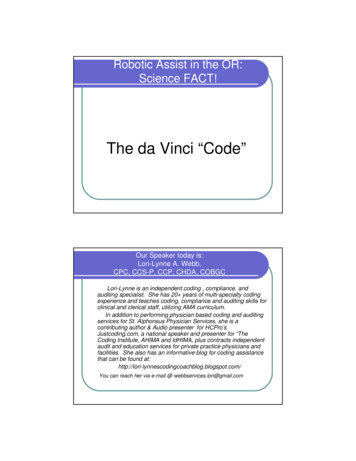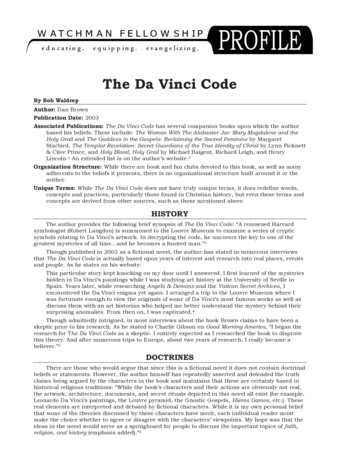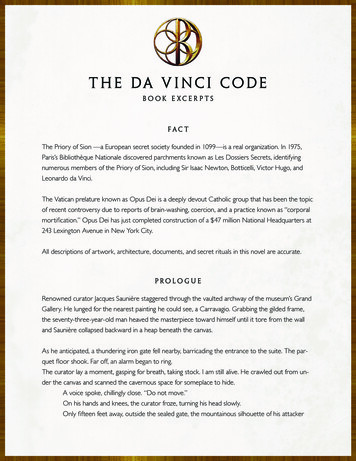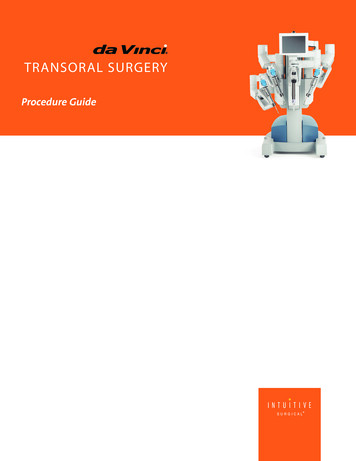
Transcription
Robotic Assist in the OR:Science FACT!The da Vinci “Code”Our Speaker today is:Lori-Lynne A. Webb,CPC, CCS-P, CCP, CHDA, COBGCLori-Lynne is an independent coding , compliance, andauditing specialist. She has 20 years of multi-specialty codingexperience and teaches codingcoding, compliance and auditing skills forclinical and clerical staff, utilizing AMA curriculum.In addition to performing physician based coding and auditingservices for St. Alphonsus Physician Services, she is acontributing author & Audio presenter for HCPro’sJustcoding.com, a national speaker and presenter for “TheCoding Institute, AHIMA and IdHIMA, plus contracts independentaudit and education services for private practice physicians andfacilities She also has an informative blog for coding assistancefacilities.that can be found You can reach her via e-mail @ webbservices.lori@gmail.com
Robotic Assisted Surgery – New TechnologiesI know a lot of you arestruggling with how tocode for roboticassisted surgery.Inpatient facilitycoders have the"luxury" of using theICD-9 procedure codeswhich are much moredescriptive and really"tell the story". butcoding for physicianfees with CPT, it ismuch more difficult.Robotic Assisted Surgery – New Technologies
Robotic Assisted Surgery -- MISRobotic-assisted surgery, also knownas “minimallyminimally invasive surgerysurgery” (MIS),(MIS)has become almost commonplace inhospital operating suites throughoutthe United States, predominantly withthe da Vinci robotic system or theZEUS robotic system.Robotic Assisted SurgeryThe use of robotics in surgerycontinues to evolveevolve, and this poseschallenges for hospitals andproviders to stay abreast of thesechanges.In turn, coders may also struggleto stay current in terms of how tocode for these procedures.
Pros and Cons of Robotic Surgery Pros: Allow exact Micro-movements for surgeons as alaparoscopic procedure 3D Imaging The ability to rotate the equipment/instruments360 degrees.degrees Quicker healing & recovery time for the patientPros and Cons of Robotic Surgery Cons: Purchase price of the equipment Longer operating room times and turn around times Finding Qualified Physicians and Operating Roomstaff to operate the equipment Insurance Company resistance to paying forprocedures performed “robotically”
Background – Where it came from . This was named for Leonardo da Vinci, who inventedthe first robot Developed in 1999 by Intuitive Surgical, Incda Vinci Surgical System da Vinci also known as a MIS or Minimally InvasiveSurgery system Over 1000 are currently in use in the United States Costs aprox 1.5 million for the unit itself, and up to 300-500,000 for accessory add-onsFast-forward to today: Currently, gynecologic and urologicsurgeries are the most common surgicalprocedures physicians are performingfwithMIS. Physicians perform both MIS-assistedprostatectomies and MIS-assistedh sterectomies whichhysterectomies,hich are twot o veryerdifferent procedures, with nearly the samefive small ¼” incisions instead of the usualopen or laparoscopic incisions
Fast forward to today: Robotic-assisted surgical procedures also allow patients tohave shorter lengths of stay in the hospital. Normally patients who undergo these procedures withoutthe robotic assistance have a length of stay of three to fivedays. Physicians performing these procedures with the MISpatients routinely have a length of stay of one to two days.*Note that coders need to be diligent in determining theappropriate place of service (POS) to coordinate with thelength of stay.The da Vinci Surgical SystemEquipmentWhat does it look like?
What the equipment looks like .1.Micro-precisiontools of therobotic device.2.Hand paddleassembly for thesurgeonWhat the equipment looks like . What thephysician lookslike as they areperforming theprocedures in theOperating Room
What the equipment looks like .A picture froman actualoperating roomof a physicianusing ada Vinci assistdeviceRobotics & Patient Safety Many patients have concerns about safety. Th daThed VinciVi i SurgerySMIS isi as safef as traditionalt ditil methods.th d.Has been used successfully in tens of thousands of minimallyinvasive procedures worldwide. Is the least invasive surgical approach and is as safe as traditionalsurgical methods. The da Vinci System cannot be programmed,programmed or make decisionson its own. The da Vinci System requires that every surgical maneuver beperformed with direct input from the surgeon.
Procedures with a da Vinci Surgical SystemAssistUrologic Procedures Include: C t tCyctectomy Partial nephrectomy Radical/complete nephrectomy Pyeloplasty Radical prostatectomyProcedures with a da Vinci AssistGeneral surgery : Gastric bypassLow anterior resectionsPulmonary lobectomyCholecystectomyNissen Hernia repair
Procedures with a da Vinci Surgical SystemAssistGynecologic HysterectomyHMyomectomySacrocolpopexyC di /thCardio/thoracici Mitral valve repair RevascularizationsProcedures with a da Vinci AssistHead/Neck/thyroid ThThymectomyOrthopaedic Total hip replacementTotal knee replacement
Let’s start with the “Male” side of thingsProstate Cancer 101 – Anatomy
Prostate Cancer Statistics1.2.3.4.5.6.Prostate cancer is the most common non-skin malignancy in menResponsiblepfor more deaths than anyy other cancer,, exceptp forlung cancer.Microscopic evidence of (prostate) cancer is found at autopsy inmany if not almost all men.The American Cancer Society (ACS) estimated that about 218,890new cases of prostate cancer were diagnosed in the United Statesduring 2007.About 1 man in 6 will be diagnosed with prostate cancer during hislifetime but only 1 man in 34 will die of itit.lifetime,A little over 1.8 million men in the United States are survivors ofprostate cancer.Prostate Cancer – Prognosis&Treatment optionsThese factors determine the prognosis &T tTreatmentt optionstiavailableil blThe stage of the cancer The Gleason score The patient’s age and general health
What the DaVinci can do &Prostate Cancer TxEffective Cancer Control:Studies have shown that experiencedsurgeons have achieved excellent results inremoving prostate cancer without leavingcancer cells behind.2. Improved and Early Return of SexualFFunction:ti3. Studies have shown that most patients have arapid return of sexual function.1.What the DaVinci can do forProstate Cancer txImproved and Early Return of Continence:1.2.3.4.Studies have shown that most patients have a rapidreturn of urinary incontinence.Improved Results Over Traditional Surgical/RadiationTreatments:Patients may benefit from surgical treatment oflocalized prostate cancer, the established goldstandard as compared to radiationstandard,radiation.Surgery has a higher and longer survival rate thanradiation or other treatments. Surgery also has alower risk of long-term complications than radiationtreatments.
What it looks like in use .You Tube – Video DaVinci 101http://www.youtube.com/watch?v ME3FziQk vs&feature emailhttp://www.youtube.com/watch?v ME3FziQk vs&feature email iframe title "YouTube video player" class "youtube-player" type "text/html" width "480" height "390"src "http://www.youtube.com/embed/ME3FziQk vs" frameborder "0" /iframe The “Female” side of things .
Female Anatomy 101Uterine Cancer - HysterectomyTreatments for Cancer A wide variety of gynecologic cancers canaffect a woman's reproductive system, which consists of the uterus, vagina, ovaries and fallopiantubes.The uterus is a hollow, muscular organ that holds a baby as itgrows inside a pregnant woman.Th ffallopianThell i ttubesb andd ovariesi are llocatedt d on eitherith sideid offthe uterus.
Uterine Cancer - Hysterectomy The most common types of gynecologic cancersare cervical, endometrial (uterine) and ovariancancer.The specific type of cancer a woman has and howadvanced it is, will determine her availabletreatment options.In the United States ,approximately 42,000 womeneach year are diagnosed with uterine cancer.Uterine Cancer is the most common malignancy ofthe female genital tract and the 4th most commoncancer diagnosis in women.Uterine Cancer - Hysterectomy Women with early stage gynecologic cancerare often treated with hysterectomy – the surgical removal of the uterus.In this procedure, the doctor may also remove theovaries, fallopian tubes and/or select lymph nodes.Hysterectomyyy is the second most common surgicalgprocedure for women in the US.An estimated one third of all U.S. women will havea hysterectomy by age 60.
da Vinci port placementvs/Traditional incisionThe Video – da Vinci Hysterectomy Robotic-Assisted Laparoscopic Hysterectomy (RALH) This video provides an explanation of the RoboticAssisted Laparoscopic Hysterectomy (RALH)procedure and the benefits it provides to patients. Thesurgical procedure in this video is performed by Dr.V di Morozov.VadimM http://www.umm.edu/media/video/misc ralh.htm http://www.youtube.com/watch?v U5dOavk0pIg
The Operative Report:OPERATIVE REPORT Total laparoscopic hysterectomy using the da Vinci robotic equipment.The abdomen and vagina were prepped and draped in the normal sterile fashion. A Foley catheter was inserted. Along weighted speculum was placed into the vagina and an anterior wall retractor was placed into the vagina.The cervix was grasped with a single-tooth tenaculum and the uterus was sounded to 7.5 cm and wasanterior.anteriorThe balloon manipulator was then properly placed. The balloon was filled to approximately 3 cc of saline. Thecervical cup was placed around the cervix. A sterile glove filled with a lap pad was then placed inside thevagina to help with pneumoperitoneum. An 11 mm port was placed in the left upper quadrant just under theinferior costal margin. Adequate pneumoperitoneum was obtained. A 12 mm port was placed supraumbilicallyand the 12 mm trocar was placed through that port. The da Vinci camera was then placed supraumbilically. 3more ports were then placed. The 11 mm port was then placed in the left upper quadrant and there were two8 mm ports that were placed 10 cm laterally to the umbilicus and 2 cm inferiorly. The da Vinci robot was thendocked in the normal fashion, The patient was placed in steep Trendelenburg positioning.Inspection of the pelvis showed a normal uterus, ovaries and tubes. The right fallopian tube was cauterized usingthe PK bipolar cautery and was ligated using the hot shears. The utero-ovarian ligament was also coagulatedand cut. The round ligament was coagulated and cut. A bladder flap was created with the hot shears and thebladder was dissected down from the cervix.This entire procedure was then repeated on the left side. The blue balloon cuff was then identified and an incisionwas made in the cervicovaginal junction on top of the vaginal cuff. This was also repeated posteriorly. Theincision was extended laterally, freeing the uterus from the surrounding vagina. The uterus was then deliveredposteriorly through the vagina using the robotic assistant. The vaginal cuff was closed with four figure-of-eightsutures of 0 Vicryl. The ureters were identified bilaterally. The entire pelvis was hemostatic. Thesupraumbilical site was closed with a suture of 0 Vicryl. The skin was closed with 4- 0 Monocryl usingsubcuticular stitches. Steri-Strips were placed. The final needle, sponge and instrument count was correct.The patient tolerated the procedure well. Patient to the recovery room in good condition.Procedure & Diagnosis CodesCodes ICD-9-3CM:68.41 Laparoscopic total abdominal hysterectomy17.42 Laparoscopicpp robotic assisted pprocedureCodes CPT58570 - Codes ICD-9-3CM:68.41 Laparoscopic total abdominal hysterectomy17.42 Laparoscopic robotic assisted procedureCodes CPT58570 Laparoscopy, surgical, with total hysterectomy, for uterus 250g or lessS2900 SurgicalS rgical techniquestechniq es requiringreq iring usese of robotic surgicals rgical systems stem (list separatelseparately in addition tocode for primary procedure)Final Diagnosis: Uterine Carcinoma (malignant) with pelvic pain.Dx Codes: 179, 625.9
CODING ROBOTICS 101Coding Hints:Hospital based ICD-9 Vol 3 ProceduresProvider Based CPT ProceduresInpatient Coding Ques . For inpatient coders, use the following ICD-9-CM-3procedure codes, (which CMS introduced in 2008)to identify procedures performed with roboticassistance. According to the ICD-9 CM-3 Chapter 17instructions: inpatient coders are to code theprimary procedure code first, the add the roboticcode(s) as a secondary code. The list belowidentifies the robotic codes –
Inpatient Coding Ques ICD-9 Volume 3: 17.411741 (open robotic assisted procedure)17.42 (laparoscopic robotic assisted procedure).17.43 (percutaneous robotic assisted procedure)17.44 (endoscopic robotic assisted procedure)17.45 (thoracoscopic robotic assisted procedure)17.49 (other and unspecified robotic assistedprocedure)Outpatient Coding Ques: In regard to professional fees (Physician fees) and billing,CPT has lagged behind in getting codes to reflect MISMIS. CPT does not currently have any codes specificallydesignated for “robotic” assistance. If the surgeon isperforming procedures with a robotic assist , you aredirected to code the “nearest” code for what the surgeonperformed. Depending on what the surgeon documented, you shoulduse the code-set for open, laparoscopic, or unlisted code (s)then add HCPCS code S2900.
Outpatient Coding Ques HCPCS code S2900 is ONLY for use with privatepayors, and not applicable forMedicare/Medicaid/Tricare claims. Include in the notes section of your claim, ""procedure performed with a robotic surgicalassist device". DO NOT APPEND MOD 22, 59, or 52.Keep your pricing the same as it would be if doneas a traditional laparoscopic or open procedure.Robotic-Assisted Radical Prostatectomy Coding andReimbursement: CPT-55866 cal, includingnerve sparing CPT-55899 UnlistedUli t dprocedure, malegenital system
Coding and ReimbursementGynecology via the da Vinci Surgical System tomy, for uterus250 g or less 58542-with removal oftube(s) and/or ovary(s) 58543-Laparoscopy,58543Laparoscopysurgical supracervicalhysterectomy, for uterusgreater than 250 g 58544-with removal of tube(s)and/or ovary(s) 58548-Laparoscopy withradical hysterectomy, withbilateral total pelviclymphadenectomy and paraaortic lymph node sampling(biopsy), with removal oftube(s) and ovary(s), ifperformedCoding and ReimbursementGynecology via the da Vinci Surgical System 58550-Laparoscopy,surgical, with vaginalhysterectomy, for uterus250 g or less 58554-with removalof tube(s) and/orovary(s) 58552- with removal oftube(s) and/or ovary(s) 58578-Unlistedlaparoscopyprocedure uterusprocedure, 58553-Laparoscopy,surgical, with vaginalhysterectomy, for uterusgreater than 250 g
“T” Codes – Category III Emerging Technology At this time there are no “T” codes to append with the CPT codingand billing processes The AMA is in the process of developing more and moreCategory III “T” codes, so the more we use the robotic assist, themore apparent it is that we work and advocate to CPT to includea code for this technology. Check out the proposed CPT category III codes being looked atfor inclusion in the 2012 code-sets athttp://www.codingbooks.com/Assets/AMA CPT Cateogory III Codes Update August 2010%281%29.pdfPayer Denial Letters – Pre Auth Some payers refuse to allow a robotic surgical assistin the OR. Pre-authorize and get in writing what the payer will/willnot consider Write letter of medical request stating the “medicalnecessity” or reasons why this would be advantagesnecessityfor your patient
Insurance Denial LetterThis is text from an actual letter denying robotic assistance (sept 2010)Dear Dr. :We have received your initial request for reconsideration of benefits for robotic assistance. Thisnotice is to inform you that based upon a review of the member’s policy, your request has beendenied.Under the terms of the member’s policy, robotic assistance must be determined to be medicallynecessary in order for the proposed service, supply, drug or other charges to be covered. Theservice does not meet our medical necessity guidelines, specifically no studies are presentedindicating significant health benefits.The member has been advised of this determination and may appeal. Any reconsiderationsubmitted by you as the provider will not impact the member’s appeal rights under their policy.Please be advised that a provider cannot exercise apeal right on behalf of a member unless theppthe pprovider as their authorized representativepbyy completingpg anmember has appointed“appointment of authorized representative form.If you have questions regarding thismatter, please contact the customer service department provideron the back of the member’s ID card.Sincerely,Pre-Service ReviewPayer policy updates Good News In response to the original denial letter inth previoustheislide lidTh payer hThehasreconsidered their policy, and a revisionwill be made Here’s the text from theactual policy revision letter .
Policy Update letter .Actual update letter text received January 2011Dear Dr :I have been asked to respond to your recent correspondence regarding our policyconcerning robotic surgery. I appreciate your concern that our policy creates confusionin the minds of some surgeons since we state the robotic surgery is not medicallynecessary.We will revise our policy in the near future to state that robotic surgery may beconsidered medically necessary. We will, however, not provide additionalreimbursement for the use of robotics. This is in consonance with the reimbursementpolicies of the three managed care organizations you kindly provided. Thank you foryour interest in ourmedical policies.SincerelyDr. MD, FAAPMedical DirectorDenial on pre-auth – What next? Determine if your provider wants to appeal for policy change with ainsurance payer Determine if the patient wants to proceed with the robotic assist. If patient wants to proceed with robotics have patient sign an advanced beneficiary type notice denoting that theymay be 100% financially responsible for their surgery pending insurancedenial.Collect payments up front from your patient per your normal office and/orhospital policyIf patient does not want to proceed with robotic assist consider and/or perform surgery as a traditional laparoscopic or openprocedure.Collect payments up front from your patient as per your normal office and/orhospital policy
Full Disclosure on your claims In the light of full disclosure – alwaysddenotet on theth notest lineli off your claiml iusage of a robotic assist in surgery(whether it be a CMS 1500 or a UB)Conclusion: What we learned1.2.3.4.5.6.What Robotic Assisted Surgery isUUsesiin variedi dSSurgicali lOOperationstiWhat an actual surgery looks likeHow to code for robotics – both facilitybased and physician basedPre-authorization’sPreauthorization s and Payer PoliciesGlossary of terms (see separate worddocument)
Q&AQuestions from theaudience ?References IntuitiveSurgical Systems * The da Vinci Surgical System - Intuitive Surgical, Inc. http://www.intuitivesurgical.com/index.aspx You-Tube www.youtube.comVol 1,2,3 (World Health Organization)AMA CPT http://www.codingbooks.com/Assets/AMA CPT Cateogory III Codes Update August 2010%281%29.pdf HCPCS (cms.hhs)(cms hhs) lori-lynnescodingcoachblog.blogspot.com CMS.HHS.org ICD-9-CM
Thank you for sharing your timewith me! I really appreciate you being such a GREAT audience!!!!!
Background - Where it came from . This was named for Leonardo da Vinci, who invented the first robot Developed in 1999 by Intuitive Surgical, Inc da Vinci Surgical System da Vinci also known as a MIS or Minimally Invasive Surgery system Over 1000 are currently in use in the United States Costs aprox 1.5 million for the unit itself, and up to










